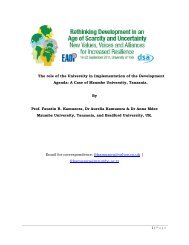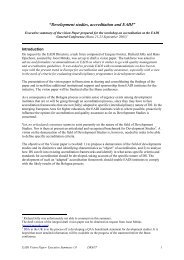Revenue Administration in Sub-Saharan Africa - International Tax ...
Revenue Administration in Sub-Saharan Africa - International Tax ...
Revenue Administration in Sub-Saharan Africa - International Tax ...
Create successful ePaper yourself
Turn your PDF publications into a flip-book with our unique Google optimized e-Paper software.
The organization of revenue bodiesChapter IIKey f<strong>in</strong>d<strong>in</strong>gsOrganizational structures/features• Most of the surveyed revenue bodies are currently implement<strong>in</strong>g majorrevenue adm<strong>in</strong>istration reforms, <strong>in</strong>clud<strong>in</strong>g organizational and <strong>in</strong>stitutionalredesign.• Majority of the revenue bodies’ organizational structures are hybrid <strong>in</strong> nature,exhibit<strong>in</strong>g features attributable to two organizational models (functional andtaxpayer segmentation).• <strong>Revenue</strong> bodies have set up a dedicated headquarters function to provideoperational policy guidance to field delivery.• As noted <strong>in</strong> Chapter I, tax and customs adm<strong>in</strong>istration rema<strong>in</strong> dist<strong>in</strong>ctdepartments <strong>in</strong> the majority of revenue bodies (except Ethiopia), only shar<strong>in</strong>gcommon corporate and a few revenue adm<strong>in</strong>istration functions.• In a number of countries, direct reports to the head of the revenue body havebeen reduced by consolidat<strong>in</strong>g oversight of all or some corporate/supportservices under a s<strong>in</strong>gle executive—Corporate/Support Services. Day-to-daysupervision of tax and customs field operations has been consolidated <strong>in</strong> somecountries under a s<strong>in</strong>gle po<strong>in</strong>t for greater oversight.Large taxpayers’ office• All revenue bodies (except Botswana) have set up a large taxpayers’ office(LTO) to adm<strong>in</strong>ister the tax affairs of a small number of large enterprises and<strong>in</strong>dividuals <strong>in</strong> some countries) that contribute 60 – 70% of tax revenue.• In l<strong>in</strong>e with <strong>in</strong>ternational practice, annual gross turnover is the ma<strong>in</strong> criteriaused <strong>in</strong> all countries for assign<strong>in</strong>g taxpayers to the LTO.• Other factors commonly used to assign taxpayers to the LTO <strong>in</strong>clude: (1)enterprises associated with or related to a large enterprise; (2) enterprisesengaged <strong>in</strong> complex or specialized operations (such as bank<strong>in</strong>g, <strong>in</strong>surance,energy, telecommunication, and m<strong>in</strong><strong>in</strong>g); (3) revenue contribution; and (4)number of employees.• Special taxation regimes for small and micro enterprises have beenimplemented <strong>in</strong> a number of countries.Staff distributionIn most countries, over 30% of staff resources are based at the headquarters and/orengaged <strong>in</strong> support activities.28





